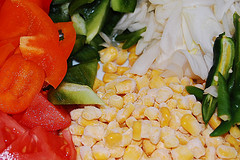Freeze Produce Now to Enjoy Summer Flavor All Year
 Nature’s bounty is at its peak as summer winds down. Are you lucky enough to have your own organic garden? It’s likely to be brimming with fresh, luscious fruits and vegetables right around now. In fact, you probably have more homegrown produce on hand than you know what to do with. Besides sharing the wealth with friends and neighbors, you can stock up for winter by freezing some of your stash. Non-gardeners may simply substitute high quality produce from their local farmers’ market or u-pick farm.
Nature’s bounty is at its peak as summer winds down. Are you lucky enough to have your own organic garden? It’s likely to be brimming with fresh, luscious fruits and vegetables right around now. In fact, you probably have more homegrown produce on hand than you know what to do with. Besides sharing the wealth with friends and neighbors, you can stock up for winter by freezing some of your stash. Non-gardeners may simply substitute high quality produce from their local farmers’ market or u-pick farm.
Why Freeze?
Freezing is a fantastic method of storage. It keeps food safe by stopping bacterial growth almost completely. Freezing also does a good job of preserving the distinctive texture and color, as well as the lion’s share of the nutrients, of most vegetables and fruits. Equally important, you don’t have to heat up the kitchen in the middle of a Florida heat wave, overtax your Orlando HVAC system, or make a major mess as you do when canning. Come winter, your frozen stash may be pulled out quickly to give variety and lift to cold weather meals. The main disadvantage of this method is that the amount of frozen foods you can stockpile is limited by the space in your home freezer.
How to Freeze
1. Start by selecting the freshest produce you can get your gardening gloves on. It should be at the peak of maturity, but not overripe. Not recommended for freezing: raw potatoes; lettuce and other salad greens; delicate sprouts; and items with a high moisture content like cucumbers, watermelon, or radishes.
2. Remove any leaves, stems, green or woody areas, or inedible seeds and then wash your goodies. Peel if desired and cut into pieces of the appropriate size and shape desired for their eventual use.
3. With a few exceptions, such as tomatoes and bell peppers, vegetables should be blanched (cooked very briefly with boiling water or steam), followed by rapid draining, drying, and cooling before they are frozen. This slows down the action of enzymes which are naturally present to aid ripening of the veggies. The happy result is veggies with more crunch, color, and vitamins than they would have if not pre-blanched.
4. For loose-pack produce – perfect if you want to be able to take out a small quantity at a time to use – spread your fruit or veggie pieces (or small bunches of fresh herbs) out in a single layer on a flat surface, such as a cookie sheet, to freeze. After they are frozen, pack tightly into storage containers. These can be re-sealable plastic bags, plastic food-safe boxes, or wide mouth glass jars such as mason jars, which can withstand extremes of temperature. A vacuum sealer is a handy device that will help maintain farm-fresh quality.
5. Solid-pack involves filling containers (preferably shallow rectangles, all the same size for easier stacking) solidly with produce. You may choose to freeze either blanched veggies or completed preparation such as vegetable soups or tomato sauces in this manner. Be sure to leave three inches of head space to allow room for expansion.
6. Wet-pack freezing is used for fruit, which is frozen cut up into a simple syrup. It can be plain, or combined with other ingredients to make freezer jam or compote.
Storage Tips
Whichever freezing method you choose, be sure to label the packaging with a description and the date. If you freeze a lot, make up a “map” of your freezer to help keep track of your inventory.
Store frozen produce at 0 degrees F or below, preferably in a standalone freezer if you don’t plan to use it in the immediate future. Fruit usually stays good for a year and vegetables maintain their quality for 18 months, as a rule.
Laura Firszt writes for networx.com.
Looking for a Pro? Call us (866) 441-6648

Electrical Average Costs
Electricians Experiences

Attic Stairs Install – High Quality, Reliable Service, Good Price

Air Conditioner Repair Fixes Sloppy Installation In A House Flip



